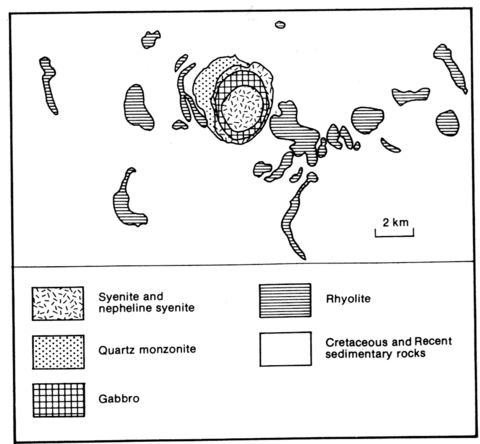stripes
The intrusive complex occupies the central part of the La Cueva dome of Cretaceous sedimentary rocks, the steep outward dips of which appear to have been caused by emplacement of the earliest phase of the La Cueva intrusion. The intrusion comprises three structural units: an early quartz monzonite that was probably laccolithic in form and domed the roof; a differentiated series varying from gabbro to syenite and nepheline syenite that cut through the monzonite, and a central plug of microsyenite. The monzonite varies from a quartz-bearing syenite to a microgranite and contains a little biotite and sodic hornblende. The differentiated series passes from an outer sodic syenite of perthite, a little aegirine-augite, sodic amphibole and analcime, some of which appears to pseusomorph nepheline, to a transition rock which contains an increasing proportion of plagioclase and mafic minerals before, at a relatively abrupt contact, it passes inwards into gabbro. Near the gabbro the transition rock contains olivine, titanium augite rimmed by aegirine and sodic hornblende. The gabbro contains a little biotite, riebeckite, calcite and analcime. The central microsyenite consists of alkali feldspar, biotite, aegirine-augite and a little olivine, riebeckite and analcime. Pyroxenite and ijolite are described as occurring in a narrow zone along a block of altered limestone lying between sodic syenite and gabbro. The ijolite forms dyke-like masses consisting of about 80% aegirine-augite and the rest principally nepheline. A sill of rhyolite some 3 km long within limestones to the northwest of the complex is peralkaline with spongy masses of sodic amphibole. Numerous other bodies of rhyolite occur in the area but are not described.
DAUGHERTY, F.W. 1963. La Cueva intrusive complex and dome, northern Coahuila, Mexico. Bulletin of the Geological Society of America, 74: 1429-38

